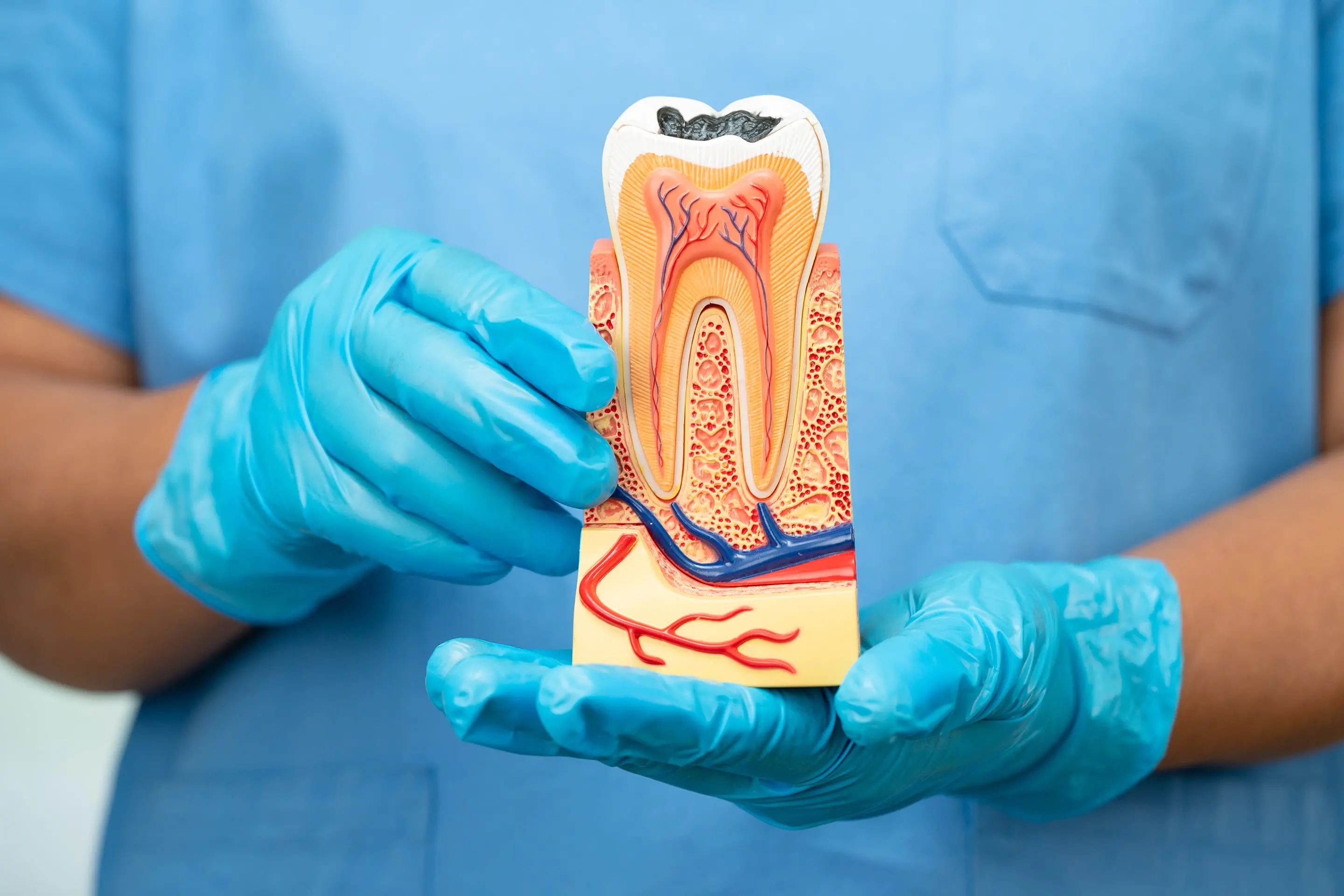A root canal is a dental procedure performed to salvage a tooth affected by severe decay or infection. The process involves removing infected or damaged pulp from within the tooth, thoroughly cleaning and disinfecting the area, and then filling and sealing it to prevent further infection. This treatment becomes necessary when the tooth’s inner soft tissue, known as pulp, becomes inflamed or infected due to deep decay, repeated dental procedures, or physical damage such as cracks or chips.
The primary objective of a root canal is to preserve the natural tooth and avoid extraction. By eliminating the infected tissue and sealing the tooth, this procedure effectively restores functionality and alleviates pain. With proper care, a tooth that has undergone a root canal can remain healthy for many years, often lasting a lifetime.
Root canals are common, routine dental procedures that play a crucial role in maintaining oral health and preserving natural teeth. Without treatment, the infection can progress, potentially spreading to surrounding tissues and forming an abscess. This can result in severe pain and may lead to more serious complications.
By addressing the issue through a root canal, patients can avoid these risks and maintain their natural smile.
Key Takeaways
- A root canal is a dental procedure to save a tooth that is infected or decayed, rather than extracting it.
- Common misconceptions about root canals include the belief that they are extremely painful and that they cause illness.
- Signs and symptoms that indicate the need for a root canal include severe toothache, sensitivity to hot or cold, and swelling in the gums.
- The procedure of getting a root canal involves removing the infected pulp, cleaning the inside of the tooth, and sealing it to prevent further infection.
- Recovery and aftercare following a root canal may include temporary discomfort and the need for a crown to protect the treated tooth.
- Potential complications and risks of root canal treatment include the possibility of reinfection and the need for additional procedures.
- Alternatives to root canal treatment include tooth extraction and replacement with a dental implant or bridge.
Common Misconceptions about Root Canals
There are several misconceptions about root canals that can cause unnecessary fear and anxiety for patients. One common misconception is that root canals are extremely painful. In reality, the purpose of a root canal is to alleviate the pain caused by an infected or damaged tooth.
With modern anesthesia and advanced techniques, most patients report that the procedure is no more uncomfortable than getting a filling. In fact, the pain associated with an infected tooth is often far worse than any discomfort experienced during a root canal procedure. Another misconception is that root canals cause illness or other health problems.
This myth originated from outdated research that has since been debunked. The truth is that root canals are a safe and effective way to treat infected teeth and preserve oral health. In fact, avoiding a root canal can lead to more serious health issues, such as an abscess or systemic infection.
It is important for patients to understand that root canals are a standard dental procedure with a high success rate and minimal risk.
Signs and Symptoms that Indicate the Need for a Root Canal
There are several signs and symptoms that may indicate the need for a root canal. One common symptom is severe tooth pain, especially when chewing or applying pressure to the tooth. This pain may be constant or intermittent and can be accompanied by swelling or tenderness in the surrounding gums.
Another sign is sensitivity to hot or cold temperatures that lingers even after the stimulus has been removed. This sensitivity may indicate that the nerve inside the tooth has been affected by infection or decay. Other symptoms that may indicate the need for a root canal include discoloration of the tooth, swelling or tenderness in the nearby gums, and a pimple-like bump on the gums near the affected tooth.
These symptoms can indicate that the pulp inside the tooth has become infected or damaged and requires treatment. It is important to seek prompt dental care if you experience any of these symptoms, as delaying treatment can lead to further complications and may require more extensive procedures.
The Procedure of Getting a Root Canal
| Procedure Step | Description |
|---|---|
| Anesthesia | The area around the tooth is numbed with local anesthesia to minimize discomfort during the procedure. |
| Access Opening | A small opening is made in the crown of the tooth to access the pulp chamber and root canals. |
| Root Canal Cleaning | The infected or damaged pulp is removed, and the root canals are cleaned and shaped to prepare for filling. |
| Root Canal Filling | The cleaned root canals are filled with a biocompatible material to seal them and prevent further infection. |
| Restoration | A filling or crown is placed on the tooth to restore its function and appearance. |
The first step in getting a root canal is to schedule an appointment with a dentist or endodontist, who is a specialist in treating the interior of the tooth. During the procedure, the dentist will numb the area around the affected tooth with local anesthesia to ensure that you are comfortable throughout the process. Once the area is numb, the dentist will create an opening in the crown of the tooth to access the pulp chamber and root canals.
Next, the infected or damaged tissue will be removed from inside the tooth using special instruments. The dentist will then clean and disinfect the area to remove any bacteria or debris. Once the area has been thoroughly cleaned, it will be filled with a biocompatible material to prevent further infection.
In some cases, a temporary filling may be placed to protect the tooth until a permanent filling or crown can be placed. After the root canal procedure is complete, it is common for the tooth to feel sensitive for a few days. Over-the-counter pain medication can help alleviate any discomfort during this time.
Once the tooth has healed, a permanent filling or crown will be placed to restore its function and appearance. With proper care, a tooth that has undergone a root canal can last a lifetime.
Recovery and Aftercare Following a Root Canal
After a root canal procedure, it is important to take good care of your teeth and gums to promote healing and prevent further complications. It is normal to experience some discomfort or sensitivity in the treated tooth for a few days after the procedure. Over-the-counter pain medication can help alleviate any discomfort during this time.
It is also important to avoid chewing on hard or sticky foods with the treated tooth until it has been fully restored with a permanent filling or crown. Maintaining good oral hygiene is crucial for recovery following a root canal. It is important to continue brushing and flossing regularly to keep the treated tooth and surrounding gums clean and healthy.
It may also be helpful to use a soft-bristled toothbrush and avoid vigorous brushing around the treated area to prevent irritation. Following any specific instructions provided by your dentist will help ensure a smooth recovery and successful outcome. It is important to attend any follow-up appointments scheduled by your dentist to monitor your progress and ensure that the treated tooth is healing properly.
If you experience severe or persistent pain, swelling, or any other unusual symptoms following a root canal, it is important to contact your dentist right away for further evaluation.
Potential Complications and Risks of Root Canal Treatment
While root canal treatment is generally safe and effective, there are potential complications and risks associated with the procedure. One possible complication is incomplete removal of infected tissue from inside the tooth, which can lead to persistent infection and require additional treatment. In some cases, a new infection may develop in the treated tooth if bacteria are able to re-enter the area through a crack or leak in the filling or crown.
Another potential risk of root canal treatment is damage to the surrounding teeth or tissues during the procedure. This can occur if instruments used during the root canal inadvertently perforate the root of the tooth or cause damage to nearby structures. Additionally, some patients may experience temporary numbness or tingling in their lips, tongue, or chin due to irritation of nerves during the procedure.
It is important for patients to discuss any concerns or questions about potential complications with their dentist before undergoing a root canal. By understanding the risks associated with the procedure, patients can make informed decisions about their dental care and take steps to minimize potential complications.
Alternatives to Root Canal Treatment
In some cases, there may be alternatives to root canal treatment depending on the specific circumstances of each patient’s dental health. One alternative option is extraction of the affected tooth followed by replacement with a dental implant, bridge, or partial denture. While extraction may seem like a simpler solution, it is important to consider the long-term impact on oral health and function.
Another alternative to root canal treatment is pulp capping, which involves placing a medicated material over an exposed pulp to encourage healing and prevent infection. Pulp capping may be suitable for cases where the pulp is only mildly irritated but has not become infected. However, this treatment is not appropriate for all situations and may not provide long-term success in cases of severe infection or damage.
It is important for patients to discuss all available treatment options with their dentist before making a decision about how to proceed with dental care. By considering alternatives to root canal treatment and weighing the potential benefits and risks of each option, patients can make informed decisions about their oral health and overall well-being.
If you’re considering a root canal, you may also want to explore the benefits of replacing lost teeth for your oral health. According to a recent article from Torrance Dental Associates, “Why Replacing Your Lost Teeth Can Save Your Oral Health,” replacing missing teeth can prevent further dental issues and improve overall oral health. To learn more about this topic, you can read the full article here.
FAQs
What is a root canal?
A root canal is a dental procedure that involves removing the infected or damaged pulp from inside a tooth and then cleaning and sealing the tooth to prevent further infection.
Why is a root canal necessary?
A root canal is necessary when the pulp inside a tooth becomes infected or damaged due to decay, trauma, or other factors. If left untreated, the infection can spread and lead to severe pain and potential tooth loss.
What are the signs that a root canal may be needed?
Signs that a root canal may be needed include severe toothache, prolonged sensitivity to hot or cold, discoloration of the tooth, swelling and tenderness in the gums, and a recurring pimple on the gums.
How is a root canal performed?
During a root canal procedure, the dentist will numb the area around the tooth and then create an opening to access the infected pulp. The infected pulp is then removed, the inside of the tooth is cleaned and disinfected, and then the tooth is sealed with a filling or crown.
Is a root canal a painful procedure?
With modern techniques and anesthesia, a root canal is not typically painful. Patients may experience some discomfort or soreness after the procedure, but this can usually be managed with over-the-counter pain medication.
What is the success rate of a root canal?
The success rate of root canal treatment is high, with the majority of treated teeth lasting a lifetime. However, there is a small risk of reinfection or complications in some cases. Regular dental check-ups and good oral hygiene can help prevent these issues.

